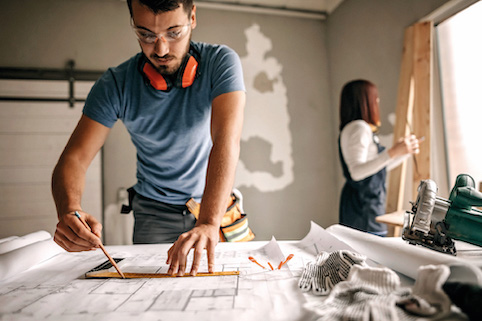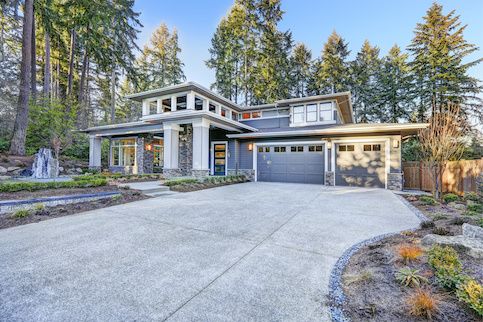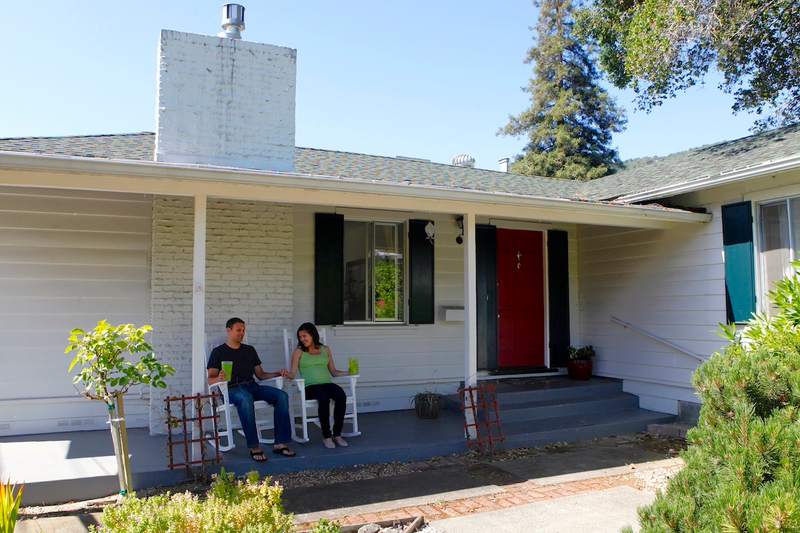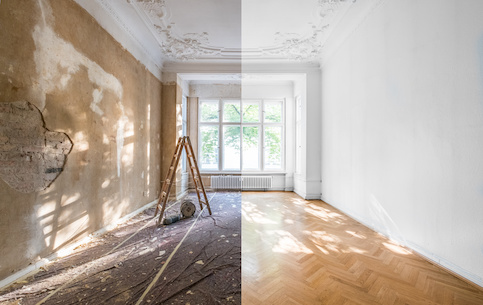Your dream home could be in a neighborhood near you – or it might only exist on a blueprint at the moment. While building a new home can be expensive, it’s a financial possibility for borrowers with a range of circumstances. Plus, you don’t need to own land or be a contractor to build a house. However, what you’ll most likely need is a construction loan.
This type of home loan can finance everything you need to build a home from the ground up. Because construction loans involve more moving parts than a traditional loan, such as hiring a contractor, purchasing materials and getting permits, they can be expensive and have more stringent eligibility requirements. Here’s how to get a construction loan that fits your financial circumstances and end up as a happy homeowner with a conventional mortgage.
What Is A Construction Loan?
A construction loan is financing for the construction of a new property. Borrowers use them to cover the costs of building their home, including the materials, permits and labor required to build on a plot of land.
Construction loans go to the borrower in installments with each step of the home-building process. This aspect helps prevent you from borrowing more than you need. Aside from the installment feature, numerous characteristics of construction loans differ from conventional mortgages, as you’ll see next.
Construction Loans Vs. Traditional Mortgages
While a traditional mortgage loan is for purchasing an existing home, a construction loan funds the work and materials to build a home from the foundation up. Additionally, while traditional mortgages have terms of 15 to 30 years, construction loans usually have a 12-month term. As a result, borrowers refinance the construction loan with a conventional mortgage once the home is built.
Construction loans are also riskier because the property securing the loan doesn’t exist yet. Lenders charge higher interest rates to compensate for the lack of collateral. They also require down payments of at least 20% to secure the loan, whereas conventional mortgages usually require a down payment of 3% – 5%.
Finally, while fixed-rate construction loans may be available with some lenders, they often have variable interest rates. These factors may raise the cost of borrowing, and the adjustable rate might create unpredictability with payments.
What’s Your Goal?
Buy A Home
Discover mortgage options that fit your unique financial needs.

Refinance
Refinance your mortgage to have more money for what matters.
Tap Into Equity
Use your home’s equity and unlock cash to achieve your goals.
How Does A Construction Loan Work?
As with a conventional mortgage, the first part of qualifying for a construction loan is putting together a budget and applying with a lender. For instance, you might estimate your costs to be $350,000 and apply for a construction loan of that amount. Remember, you won’t receive the amount all at once, nor do you have to use the entire amount. Instead, construction loans come in installments known as “draws” that fund each step of the home-building process.
For example, the borrower might start by obtaining permits and hiring a contractor to draft the blueprint. In that case, they would draw the amount needed to fund these efforts before moving on to the next steps, such as digging a foundation.
However, lenders typically require inspections at each step to ensure the build is going as expected. So, each draw means getting approval from the lender of the work thus far before more funds are disbursed.
Instead of monthly payments on the approved loan size, the borrower only pays the interest on the borrowed amount while building the home. This helps minimize costs during the build phase. The loan typically lasts for 12 months, so the borrower must finish building within that time frame. Then, depending on the loan type, the debt either converts to a traditional mortgage with the same lender or must be refinanced to become a mortgage.
The other option is to pay the full amount after the home is built. Because most borrowers don’t have the resources to do so, converting/refinancing to a traditional mortgage is the common route.
Ready To Become A Homeowner?
Get matched with a lender that can help you find the right mortgage.
What Types Of Construction Loans Are Available?
Numerous types of construction loans can help borrowers build their homes from scratch. You may qualify for one or more of the following, depending on your circumstances:
Construction-Only Loans
A construction-only loan provides the funds to cover the cost of construction. After the term ends, you’ll need another home loan to refinance the construction loan into a mortgage.
As a result, you’ll go through two separate application and closing processes. This usually entails submitting all the documentation and paperwork for both loans and paying closing costs twice.
On the upside, construction-only loans allow borrowers to shop around for a mortgage. This way, you can find the best terms and rates available for a conventional mortgage while construction is underway.
Construction-To-Permanent Loans
A construction-to-permanent loan streamlines the financing process by seamlessly transitioning from a construction loan to a permanent mortgage upon project completion.
Unlike the construction-only type, this loan consolidates all financing into one transaction, simplifying the application and closing processes. You can save time and money by eliminating the need for separate applications and closings, as you’ll only incur closing costs once.
Plus, with a construction-to-permanent loan, the worry of securing financing for a mortgage post-construction is alleviated. Once approved for the loan, you bypass the need for re-approval for a mortgage – it’s already part of the deal.
Owner-Builder Construction Loans
Owner-builder construction loans cater to borrowers who want to oversee their home construction as their own general contractor. This option means instead of hiring a builder to handle the project, you build the house yourself. While this approach can yield significant savings, it’s usually restricted to those with established experience in home building and the necessary license to act as the contractor for the project.
FHA 203(k) Loans
Federal Housing Administration (FHA) 203(k) construction loans finance new home construction and significant renovation projects to existing homes. This type of loan is like the construction-to-permanent loan, but it has government backing. As a result, it has the relaxed standards of typical FHA mortgage loans:
- Debt-to-income ratios of up to 50%
- Minimum credit score of 500 (a score of 580 helps you qualify with more lenders and get better rates)
- Minimum down payment of 3.5% (or 10% for credit scores below 580)
The FHA construction loan becomes a permanent traditional mortgage once the home is built. So, this type also saves time, stress and money by only requiring approval and closing for one loan.
VA Construction Loans
Eligible borrowers can use Department of Veterans Affairs (VA) construction loans to finance new home construction and purchase land if necessary. These loans offer the same benefits as typical VA mortgage loans:
- No down payment
- Low interest rates
- Option to roll closing costs into the loan
These loans come in construction-only and construction-to-permanent forms. Additionally, if you need to buy land with the loan, you’ll have three loans and three closings: once for the land, once for construction, and once for refinancing. Lastly, while you won’t owe a down payment, you’ll pay a VA funding fee instead. This fee ranges from 0.5% to 3.3% of the loan amount and is waived for any veterans that have a VA-approved disability.
Renovation Loans
If you’re a homeowner, a renovation loan can finance significant upgrades and repairs to the home. Instead of funding a project to build a home, you’ll use the loan for renovations. Here are the types you can apply for:
FHA 203(k) loans
An FHA 203(k) rehabilitation loan has FHA standards and comes in two forms. First, you can get a limited 203(k) mortgage to add up to $35,000 to your loan amount for renovations. For example, you might take out a $275,000 mortgage and an additional $25,000 to redo the bathroom. Second, you can get a standard 203(k) mortgage to afford rehabilitation projects over $35,000. You’ll submit plans for your renovation to an FHA-approved consultant, who must give approval for you to receive the loan.
Fannie Mae HomeStyle loans
Fannie Mae HomeStyle loans allow borrowers to renovate the home they’re purchasing or refinancing. The minimum down payment is 3% for first-time home buyers and HomeReady-eligible borrowers and 5% for everyone else. You’ll also need a 620 credit score and a DTI of 50% or less. The loan size maximum is the conforming loan limit ($766,500 in 2024). The loan will finance up to 75% of the renovation costs in most cases. You’ll likely receive lower interest rates for this loan than for a home equity loan or home equity line of credit (HELOC). You’ll need to work with a lender-approved contract and have plans drawn up ahead of time to receive funding.
Freddie Mac CHOICERenovation loans
Freddie Mac provides a renovation loan similar to that of Fannie Mae. One distinction is that this loan can help repair damage from disasters or make improvements to protect homes from future disasters.
USDA renovation loans
These loans are for low-income borrowers in rural areas. They offer affordable payments and up to $35,000 for non-structural repairs. Structural repairs can go beyond $35,000 when approved by a qualified inspector.
End Loans
The phrase “end loan” refers to the mortgage you take out to pay off your construction-only loan. In other words, when you use a construction-only loan, you refinance with an end loan, which becomes your mortgage.
Take The First Step To Buying A Home
Find a lender that will work with your unique financial situation.
How To Get A Construction Loan
The following process is how to apply for a construction loan successfully:
1. Find A Licensed Home Builder
A reputable builder is crucial for ensuring the success of your project. The National Association of Home Builders (NAHB) has an online directory to help you find a licensed builder to develop a plan and oversee the construction process. Additionally, you may have to submit the builder’s information and the company you’re hiring to your lender for approval before getting started.
2. Draw Up A Construction Plan
Next, you’ll work with your chosen builder to develop a comprehensive construction plan that includes all the details of the project, such as design, materials, timeline and budget. This plan will be essential for securing financing because the lender must approve the total expenses and time frame for the build.
3. Check Your Financial Information
It’s also crucial to review your finances and improve any areas needed to qualify for a loan:
- Credit score: The credit score requirements vary by construction loan type, as noted above. For instance, a loan with a conventional lender usually requires a score of 620, while an FHA loan requires a score of 500 with a down payment of 10%. Remember, higher scores will help you receive better terms and rates.
- Debt-to-income ratio (DTI): Similarly, the DTI requirement depends on the loan type and lender requirements. It’s advisable to have a DTI beneath 50% to qualify for various construction loans.
- Down payment: Borrowers taking out a Fannie Mae or Freddie Mac loan will have a down payment of 3% to 5%. FHA construction loans require a 3.5% down payment for borrowers with credit scores of 580 and above, while scores below the threshold require 10% down. Conventional loans often require 20% down. VA loans don’t require a down payment, but you will pay a VA funding fee.
- Verifiable income: As with any mortgage, you’ll provide your lender proof of income to show you can afford your monthly loan payment. You’ll also provide 2 years of tax returns to demonstrate stability in your financial track record.
4. Choose A Mortgage Lender
Research and compare mortgage lenders who offer construction loans. Consider factors such as interest rates, fees, terms and customer service reputation. Then, choose the lender that best meets your needs and preferences.
5. Apply For Your Loan
Submit your loan application to the chosen lender. Provide all required documentation, including your construction plan, permits and financial information. The lender will review your application and make a decision based on these qualifications.
6. Buy Homeowners Insurance
Once your construction loan is approved, purchase homeowners insurance with builder’s risk coverage. This will protect you financially in case anything goes wrong with the project. Plus, your lender may require it. You convert to a regular homeowners insurance policy once construction is finished.
Construction Loan FAQs
Here are the answers to some frequently asked questions to clarify significant aspects of construction loans.
The Bottom Line
Understanding construction loans is essential for borrowers hoping to build or renovate a home. You’ll need to navigate the various types of construction loans available, grasp the stringent qualification requirements and follow the step-by-step process to obtain a construction loan that fits your budget. Remember, a thorough plan from the outside can help make for a streamlined, cost-efficient building process once you break ground.

Ashley Kilroy
Ashley Kilroy is an experienced financial writer who writes for solo entrepreneurs as well as for Fortune 500 companies. She is a finance graduate of the University of Cincinnati. When Ashley isn’t helping people understand their finances, you may find her cage-diving with great whites or on safari in South Africa.












